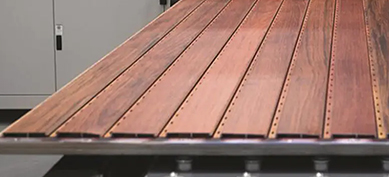When selecting materials for a construction or renovation project, professionals and homeowners alike delve into the specifications that define a product’s quality and suitability. For overhead applications, the pvc ceiling panel has emerged as a prevalent choice, prized for its durability, moisture resistance, and aesthetic versatility. However, beneath the surface of color and style lies a critical technical foundation: density and thickness. These two physical properties are not just numbers on a datasheet; they are the fundamental determinants of a panel’s performance, longevity, and ultimate value.
Defining the Core Concepts: What Are Density and Thickness?
Before analyzing their impact, it is essential to establish clear, professional definitions for density and thickness in the context of a pvc ceiling panel. While they may seem straightforward, a nuanced understanding is key to appreciating their role in the product’s performance.
What is the Thickness of a pvc ceiling panel?
Thickness is the most intuitive of the two properties. It refers to the measurement of a single pvc ceiling panel from its top surface to its bottom surface, typically expressed in millimeters (mm) or, in some markets, mils. This is a linear dimension that is easily verified with a caliper tool. It is a primary factor in the perceived sturdiness of the panel. When a buyer asks about the “weight” or “heft” of a panel, they are often indirectly referring to its thickness. Common thicknesses for a pvc ceiling panel range from around 5mm to 12mm, with different profiles suited to various applications. It is a critical specification that directly influences the panel’s structural rigidity and its ability to resist sagging over time, especially in wider spans.
What is the Density of a pvc ceiling panel?
Density, a less obvious but equally vital property, is a measure of mass per unit volume. For a pvc ceiling panel, it indicates how much polyvinyl chloride resin and other compounding materials are packed into a given space within the panel’s structure. It is usually measured in kilograms per cubic meter (kg/m³). A higher density signifies a more compact and consolidated material matrix. This is crucial because the density of a pvc ceiling panel directly correlates with its mechanical strength, impact resistance, and overall structural integrity. Unlike thickness, which is a simple measurement, density is a quality indicator of the raw materials and the manufacturing process. Two panels of identical thickness can exhibit vastly different performance characteristics if their densities differ significantly.
The Critical Role of Thickness in Performance and Application
The thickness of a pvc ceiling panel is a decisive factor that influences not only its physical behavior but also the scope of its suitable applications. It is a key specification that contractors and designers scrutinize during the material selection phase.
Structural Integrity and Sag Resistance. A primary function of any ceiling system is to remain stable and planar over its intended lifespan. The thickness of a pvc ceiling panel is directly proportional to its bending stiffness. Thicker panels possess a higher moment of inertia, meaning they are inherently more resistant to bending under their own weight. This is a critical consideration for avoiding sagging, particularly in installations where the panels are supported by widely spaced battens or in environments with temperature fluctuations. A pvc ceiling panel that is too thin for a given grid spacing will inevitably bow or dip over time, leading to an unsightly and unprofessional appearance that requires costly remediation. Therefore, selecting the appropriate thickness is a fundamental step in ensuring a long-lasting, aesthetically pleasing installation.
Impact Resistance and Durability. While the inherent flexibility of PVC offers some resistance to impact, the thickness of the panel is the key determinant of its ability to withstand physical contact. A thicker pvc ceiling panel can absorb more energy before deforming or cracking. This is a vital attribute in commercial settings such as schools, hospitals, or retail spaces where accidental contact with cleaning equipment, ladders, or other objects is possible. Even in residential settings, a thicker panel provides greater peace of mind during maintenance or when storing items in an attic space above the ceiling. The durability conferred by adequate thickness translates directly into reduced long-term maintenance and replacement costs, a key selling point for buyers focused on total cost of ownership.
Acoustic and Thermal Insulation Properties. Thickness also plays a moderating role in the insulation capabilities of a pvc ceiling panel. A thicker panel provides a greater mass barrier to sound transmission and heat flow. For sound, a thicker panel can help in dampening airborne noises to a more significant degree than a very thin one. In terms of thermal insulation, while a pvc ceiling panel is not a primary insulation material, a thicker version can contribute to reducing heat transfer, potentially aiding in energy efficiency when used in conjunction with proper insulation batts above. This makes the specification of thickness an important part of meeting the performance requirements for moisture resistant ceiling solutions in rooms like bathrooms and kitchens, where temperature and humidity levels can vary greatly.
The following table summarizes the general application guidance based on panel thickness:
| Thickness Range | Typical Applications and Considerations |
|---|---|
| 5mm - 7mm | Residential bathrooms, powder rooms, and small areas. Suitable for tight budgets and standard grid spacing. May be less resistant to significant impact and is best for ceilings with minimal above-space activity. |
| 8mm - 10mm | Standard residential kitchens, commercial kitchens, retail spaces, and corridors. Offers a robust balance of cost and performance. Provides good sag resistance for standard spans and improved durability for medium-traffic areas. |
| 11mm and above | High-end applications, large commercial spaces, and areas requiring enhanced acoustic or thermal performance. Provides maximum rigidity for wide spans, superior impact resistance, and the best insulation contribution. Ideal for fire retardant ceiling systems where a more substantial material is often specified. |
The Profound Impact of Density on Quality and Longevity
If thickness is the skeleton of a pvc ceiling panel, then density is its muscle. It is the defining characteristic that separates a premium, long-lasting product from a substandard one that may fail prematurely. Understanding density is crucial for anyone involved in the procurement of building materials.
Mechanical Strength and Load-Bearing Capacity. The density of a pvc ceiling panel is a direct indicator of its tensile and flexural strength. A high-density panel is manufactured under higher pressure and with a superior formulation of PVC compound, resulting in a more homogeneous and robust internal structure. This means it can withstand greater mechanical stress without cracking, splitting, or breaking. This is particularly important during and after installation. A high-density pvc ceiling panel is less likely to be damaged during handling or if it needs to support the weight of integrated light fixtures or ventilation grilles. For wholesalers and buyers, promoting products with certified high density is a marker of quality and reliability, aligning with the search for durable pvc ceiling panels.
Surface Hardness and Scratch Resistance. The daily maintenance and cleaning of a ceiling can, over time, lead to superficial wear. The density of a pvc ceiling panel directly influences its surface hardness and its ability to resist scratching and scuffing. A low-density panel has a more porous and softer surface, which is susceptible to marks from abrasive cleaners or dusting tools. Conversely, a high-density panel features a much harder and more consolidated surface that maintains its smooth, pristine appearance through repeated cleaning cycles. This attribute is essential for maintaining hygiene and appearance in settings like healthcare facilities and food preparation areas, where ceilings are subject to frequent and rigorous cleaning protocols.
Long-Term Dimensional Stability. All building materials are subject to the effects of thermal expansion and contraction. However, a high-density pvc ceiling panel exhibits superior dimensional stability compared to a low-density counterpart. The compact molecular structure of a dense panel is less prone to significant expansion and contraction with temperature changes. This minimizes the risk of unsightly gaps opening up at the joints or, conversely, buckling from compression. This stability is a critical factor in ensuring the long-term aesthetic integrity of the installation. It prevents the need for frequent adjustments and repairs, making it a key consideration for projects requiring a low maintenance ceiling solution. Furthermore, high density often correlates with better color consistency and UV stability, ensuring the panel does not become brittle or fade unevenly over time.
The Interplay: How Density and Thickness Work Together
Density and thickness are not independent variables; they function in concert to define the overall performance envelope of a pvc ceiling panel. A comprehensive understanding requires an analysis of their synergy.
The Compensatory Relationship. In an ideal world, every pvc ceiling panel would feature both high density and generous thickness. However, cost and practical considerations often lead to trade-offs. It is here that the relationship between the two properties becomes critical. A thinner panel with a very high density can sometimes outperform a thicker panel with a low density in terms of mechanical strength and surface durability. The high-density thin panel will be more resistant to impact and scratching, while the low-density thick panel may feel hollow and be prone to cracking upon impact. This is why judging a panel solely by its thickness can be misleading. A savvy buyer or specifier will always consider both metrics together. The goal is to find a product that strikes the optimal balance for the specific application, ensuring that it is neither over-engineered (and unnecessarily expensive) nor under-specified (and prone to failure).
Identifying the Sweet Spot for Different Projects. The interplay between density and thickness guides the selection process. For a residential bathroom where budget is a primary concern and structural demands are low, a medium-thickness panel with a standard density may be perfectly adequate. However, for a hotel corridor with high footfall and stringent durability requirements, the specification would likely lean towards a panel with above-average density, even if its thickness is only moderate. This combination ensures the surface can withstand cleaning and minor impacts while maintaining its shape. For large-format ceilings in commercial atriums, the priority shifts towards maximum rigidity to prevent sagging, necessitating a thicker panel, with high density being a prerequisite to ensure that thickness is effective. Recognizing these nuances allows wholesalers to guide their clients more effectively and helps buyers make selections that deliver performance and value.

 English
English Español
Español



